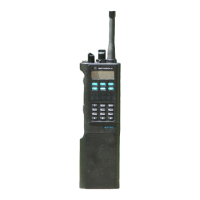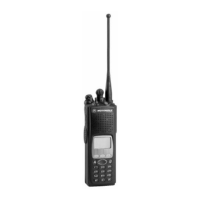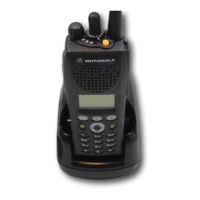Do you have a question about the Motorola ASTRO Digital XTS 3000 and is the answer not in the manual?
| Zones | 16 |
|---|---|
| Display | Alphanumeric LCD |
| Frequency Range | 136-174 MHz, 380-470 MHz |
| Power Output | 1-5 W |
| Weight | 14.5 oz (with standard battery) |
| Battery | Li-ion |
| Trunking | Yes |
| Encryption | AES, DES |
| Operating Temperature | -30°C to +60°C |
Explains symbols like WARNING, CAUTION, and Notes used in the manual.
Step-by-step instructions for selecting a zone and channel on the radio.
Guide to initiating individual calls using the radio's features.
Instructions for checking the shipping carton and contents for damage upon receipt.
Identifies and describes the radio's physical controls, buttons, and knobs.
Detailed explanation of the radio's components and their functions.
Step-by-step instructions for attaching and detaching the radio's antenna.
Procedures for properly installing and removing the radio's battery pack.
Instructions for attaching and removing the belt clip accessory.
Steps for installing and removing the cover for the universal connector.
Procedures for powering the radio on and off, including self-test.
How to select the desired operating zone and channel on the radio.
Methods for selecting specific channels within an active zone.
Instructions on how to receive and transmit communications.
How to view and manage stored lists of names and numbers.
Steps to modify existing entries within a radio list.
How to select specific items from saved lists.
Covers keypad tone muting and transmission time-out features.
Instructions for setting and changing the radio's password.
Security feature for radios with encryption keys to protect usage.
How to enable or disable the radio lock feature via the keypad.
How the radio notifies the user of a low battery condition.
How to send predefined status or message calls to a dispatcher.
Procedures for using the radio's emergency alarm and call functions.
Methods for safely ending an active emergency state.
How the radio's emergency state persists even when powered off.
Defines various types of one-on-one communication calls.
How to choose and initiate different types of individual calls.
Detailed steps for utilizing telephone call capabilities.
How to redial or recall the last contacted number or ID.
Procedures for calling stored numbers from the radio's memory list.
How to dial a number not previously stored in the radio.
Steps for responding to various types of incoming individual calls.
How to override coded squelch settings for channel access.
How to activate repeaters to extend communication range.
How to select between repeater and direct talkaround modes.
Overview of how to monitor multiple channels by scanning.
Steps to enable or disable the channel scanning feature.
How to temporarily remove unwanted channels from scan lists.
How to alter channel priority during scan operations.
Instructions for adding or removing channels from scan lists.
How to choose different squelch modes for channel reception.
Explanation of the feature that prevents transmissions on busy channels.
How dispatchers can reassign radios to temporary special channels.
How to notify the dispatcher about a desired regrouping assignment.
How radios are classified by dispatch for channel access control.
How to view the ID of the radio currently being received.
How the radio's ID is automatically sent during transmissions.
Provides high-level voice security using Motorola digital encryption.
How to choose between secure encryption and clear transmission modes.
Procedures for loading and erasing encryption keys using KVL.
An alternative method for erasing all encryption keys from the radio.
How to select groups of encryption keys (indices).
How to choose the transmit power level for the radio.
Features related to managing operations within a trunking system.
How to override busy channel indications in trunking systems.
How the radio operates during a complete trunking system failure.
How the radio behaves when it loses system signal range.
How to lock the radio to a specific site to prevent roaming.
How a site reverts to trunking during communication loss.
How to view and manually change the radio's current site.
Definitions of technical terms and acronyms used in the manual.
Explains the different alert tones and their meanings.
Explains symbols and indicators shown on the radio's display.
Instructions for charging, handling, and disposing of rechargeable batteries.
Provides advice for optimal radio operation and basic troubleshooting.
Guidelines for cleaning and handling the radio to ensure longevity.
Safety precautions when installing equipment near vehicle air bags.
Information on repair, maintenance, and extended service plans.











